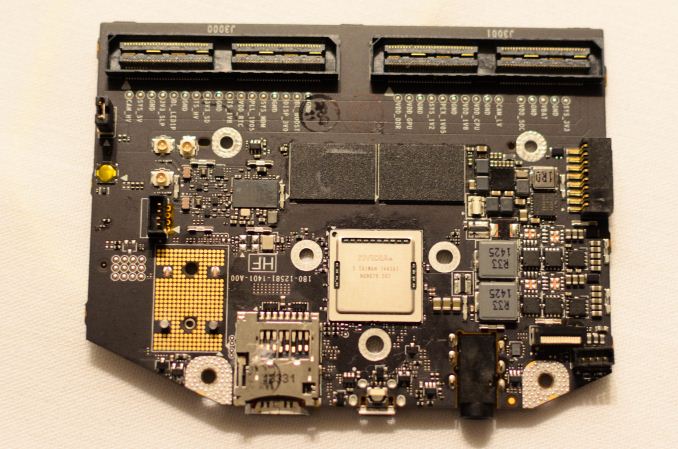NVIDIA Tegra X1 Preview & Architecture Analysis
by Joshua Ho & Ryan Smith on January 5, 2015 1:00 AM EST- Posted in
- SoCs
- Arm
- Project Denver
- Mobile
- 20nm
- GPUs
- Tablets
- NVIDIA
- Cortex A57
- Tegra X1
Final Words
With the Tegra X1, there have been a great deal of changes when compared to Tegra K1. We see a move from Cortex A15 to A57 on the main cluster, and a move from a single low power Cortex A15 to four Cortex A53s which is a significant departure from previous Tegra SoCs. However, the CPU design remains distinct from what we see in SoCs like the Exynos 5433, as NVIDIA uses a custom CPU interconnect and cluster migration instead of ARM’s CCI-400 and global task scheduling. Outside of these CPU changes, NVIDIA has done a great deal of work on the uncore, with a much faster ISP and support for new codecs at high resolution and frame rate, along with an improved memory interface and improved display output.
Outside of CPU, the GPU is a massive improvement with the move to Maxwell. The addition of double-speed FP16 support for the Tegra X1 helps to improve performance and power efficiency in applications that will utilize FP16, and in general the mobile-first focus on the architecture makes for a 2x improvement in performance per watt. While Tegra K1 set a new bar for mobile graphics for other SoC designers to target, Tegra X1 manages to raise the bar again in a big way. Given the standards support of Tegra X1, it wouldn’t be a far leap to see more extensive porting of games to a version of SHIELD Tablet with Tegra X1.
NVIDIA has also made automotive applications a huge focus in Tegra X1 in the form of DRIVE CX, a cockpit computing platform, and DRIVE PX, an autopilot platform. Given the level of integration and compute present in both DRIVE CX and PX, there seems to be a significant amount of value in NVIDIA’s solutions. However, it remains to be seen whether OEMs will widely adopt these solutions as car manufacturers can take multiple years to implement a new SoC. Compared to the 3-4 month adoption rate of an SoC in a phone or tablet, it's hard to pass any judgment on whether or not NVIDIA's automotive endeavors will be a success.
Overall, Tegra X1 represents a solid improvement over Tegra K1, and now that NVIDIA has shifted their GPU architectures to be targeted at mobile first, we’re seeing the benefits that come with such a strategy. It seems obvious that this would be a great SoC to put in a gaming tablet and a variety of other mobile devices, but it remains to be seen whether NVIDIA can get the design wins necessary to make this happen. Given that all of the high-end SoCs in the Android space will be shipping with A57 and A53 CPUs, the high-end SoC space will see significant competition once again.













194 Comments
View All Comments
tipoo - Monday, January 5, 2015 - link
Oh I read that wrong, you meant the games, not the play store. Still, games almost never crash on this either.PC Perv - Monday, January 5, 2015 - link
Why do you guys write what essentially is a PR statements by NV as if they were independently validated facts by yourselves? I suppose you guys did not have time to test any of these claims.So you end up writing contradictory paragraphs one after another. In the first, you say NVIDIA "embarked on a mobile first design for the first time." That statement in and of itself is not something one can prove or disprove, but in the very next paragraph you write,
"By going mobile-first NVIDIA has been able to reap a few benefits.. their desktop GPUs has resulted chart-topping efficiency, and these benefits are meant to cascade down to Tegra as well." (??)
I suggest you read that paragraph again. Maybe you missed something, or worse the whole paragraph comes off unintelligible.
ABR - Monday, January 5, 2015 - link
Well the situation itself is confusing since NVIDIA might have designed Maxwell "mobile-first" but actually released it "desktop-first". Then came notebook chips and now we are finally seeing Tegra. So release-wise the power efficiency "cascades down", even though they presumably designed starting from the standpoint of doing well under smaller power envelopes.PC Perv - Monday, January 5, 2015 - link
But that is a tautology that is totally vacuous of meaning. One can say the opposite thing in the exact same way: "We went with desktop first, but released to mobile first, so that power efficiency we've learned "cascaded up" to the desktops.So the impression one gets from reading that explanation is that it does not matter whether it was mobile first or desktop first. It is a wordplay that is void of meaningful information. (but designed to sound like something, I guess)
Yojimbo - Monday, January 5, 2015 - link
Isn't that standard reviewing practice? "Company X says they did Y in their design, and it shows in Z." The reviewer doesn't have to plant a mole in the organization and verify if NVIDIA really did Y like they said. This is a review, not an interrogation. If the results don't show in Z, then the reviewer will question the effectiveness of Y or maybe whether Y was really done as claimed. Yes, the logical flow of the statement you quoted is a bit weak, but I think it just has to do with perhaps poor writing and not from being some sort of shill, like you imply. The fact is that result Z, power-efficiency, is there in this case and it has been demonstrated on previously-released desktop products.As far as your statement that one could say the opposite thing and have the same meaning, I don't see it. Because going "mobile-first" means to focus on power-efficiency in the design of the architecture. It has nothing to do with the order of release of products. That is what the author means by "mobile-first," in any case. To say that NVIDIA was going "desktop-first" would presumably mean that raw performance, and not power-efficiency, was the primary design focus, and so the proper corresponding statement would be: "We went desktop-first, but released to mobile first, and the performance is meant to "cascade up" (is that a phrase? probably should be scale up, unless you live on a planet where the waterfalls fall upwards) to the desktops." There are two important notes here. Firstly, one could not assume that desktop-first design should result in increased mobile performance just because mobile-first design results in increased desktop efficiency. Secondly and more importantly, you replaced "is meant to" with "so". "So" implies a causation, which directly introduces the logical problem you are complaining about. The article says "is meant to," which implies that NVIDIA had aforethought in the design of the chip, with this release in mind, even though the desktop parts launched first. That pretty much describes the situation as NVIDIA tells it (And I don't see why you are so seemingly eager to disbelieve it. The claimed result, power-efficiency, is there, as I previously said.), and though maybe written confusingly, doesn't seem to have major logical flaws: "1. NVIDIA designed mobile-first, i.e., for power-efficiency. 2. We've seen evidence of this power-efficiency on previously-released desktop products. 3. NVIDIA always meant for this power-efficiency to similarly manifest itself in mobile products." The "cascade down" bit is just a color term.
Yojimbo - Monday, January 5, 2015 - link
I just want to note that I don't think the logical flow of the originally-written statement is as weak as I conceded to in my first paragraph. In your paraphrase-quote you left out the main clause and instead included a subordinate clause and treated it as the main clause. The author is drawing a parallel and citing evidence at the same time as making a logical statement and does so in a way that is a little confusing, but I don't think it really has weak logical flow.chizow - Monday, January 5, 2015 - link
Anyone who is familiar with the convergence of Tegra and GeForce/Tesla roadmaps and design strategy understands what the author(s) meant to convey there.Originally, Nvidia's design was to build the biggest, fastest GPU they could with massive monolithic GPGPUs built primarily for intensive graphics and compute applications. This resulted in an untenable trend with increasingly bigger and hotter GPUs.
After the undeniably big, hot Fermi arch, Nvidia placed an emphasis on efficiency with Kepler, but on the mobile side of things, they were still focusing on merging and implementing their desktop GPU arch with their mobile, which they did beginning with Tegra K1. The major breakthrough for Nvidia here was bringing mobile GPU arch in-line with their established desktop line.
That has changed with Maxwell, where Nvidia has stated, they took a mobile-first design strategy for all of their GPU designs and modularized it to scale to higher performance levels, rather than vice-versa, and the results have been obvious on the desktop space. Since Maxwell is launching later in the mobile space, the authors are saying everyone expects the same benefits in terms of power saving from mobile Maxwell over mobile Kepler that we saw with desktop Maxwell parts over desktop Kepler parts (roughly 2x perf/w).
There's really no tautology if you took the time to understand the development and philosophy behind the convergence of the two roadmaps.
Mondozai - Monday, January 5, 2015 - link
No, it's not untelligible for reasons that other people have already explained. If you understand the difference between what it is developed for and what is released first you understand the difference. And apparently you don't.OBLAMA2009 - Monday, January 5, 2015 - link
man nvidia is such a jokeMasterTactician - Monday, January 5, 2015 - link
512 GFLOPS... 8800GTX in a phone, anyone? Impressive.